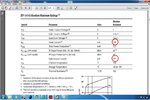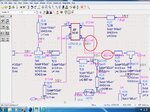pusparaga
Full Member level 4
Sir,
I took the Avago Technologies ATF54143 transistor to my work, I have chosen transistor of Vds =3V and Ids =60mA and am getting following values
(1) Vds= 3.00 V
(2) Ids =61.6mA
(3) Ig=1.82pA or sometimes getting 0 A ,when varying the resistors.
According to the transistor absolute maximum rating as follows
Vds = 5 v
Vgs= -5 to 1 v
Ids = 120 mA
Igs= 2mA
I have doubt on the Ig = 1.82pA, absolute maximum rating is Igs= 2mA. If I get this much low current at Gate, will transistor amplify it and also set Vds =3.00v and Ids =61.6mV. Is these values are o.k for biasing Vds =3v and Ids= 60mA.
Can you anybody clarify these doubts, I have attached obtained Vds , Igs and Vgs image and absolute maximum rating datasheet and also datasheet of ATF54143.
I took the Avago Technologies ATF54143 transistor to my work, I have chosen transistor of Vds =3V and Ids =60mA and am getting following values
(1) Vds= 3.00 V
(2) Ids =61.6mA
(3) Ig=1.82pA or sometimes getting 0 A ,when varying the resistors.
According to the transistor absolute maximum rating as follows
Vds = 5 v
Vgs= -5 to 1 v
Ids = 120 mA
Igs= 2mA
I have doubt on the Ig = 1.82pA, absolute maximum rating is Igs= 2mA. If I get this much low current at Gate, will transistor amplify it and also set Vds =3.00v and Ids =61.6mV. Is these values are o.k for biasing Vds =3v and Ids= 60mA.
Can you anybody clarify these doubts, I have attached obtained Vds , Igs and Vgs image and absolute maximum rating datasheet and also datasheet of ATF54143.


